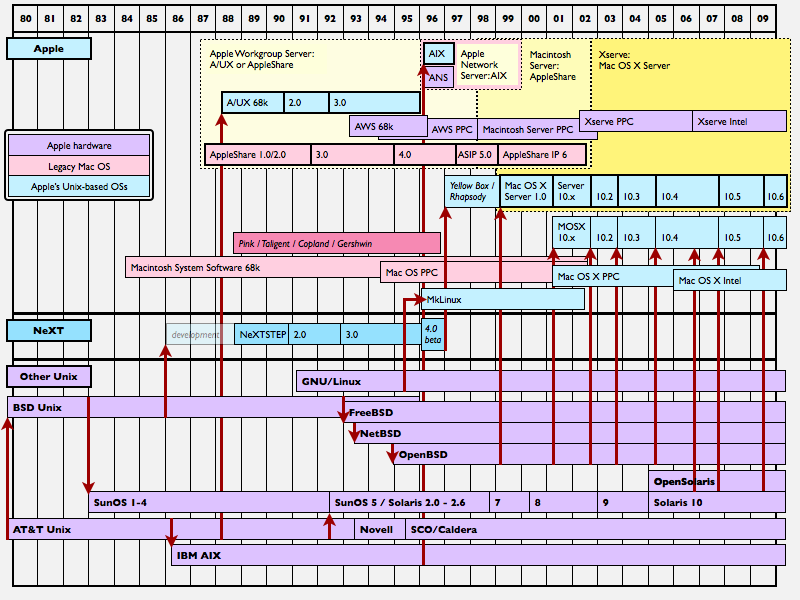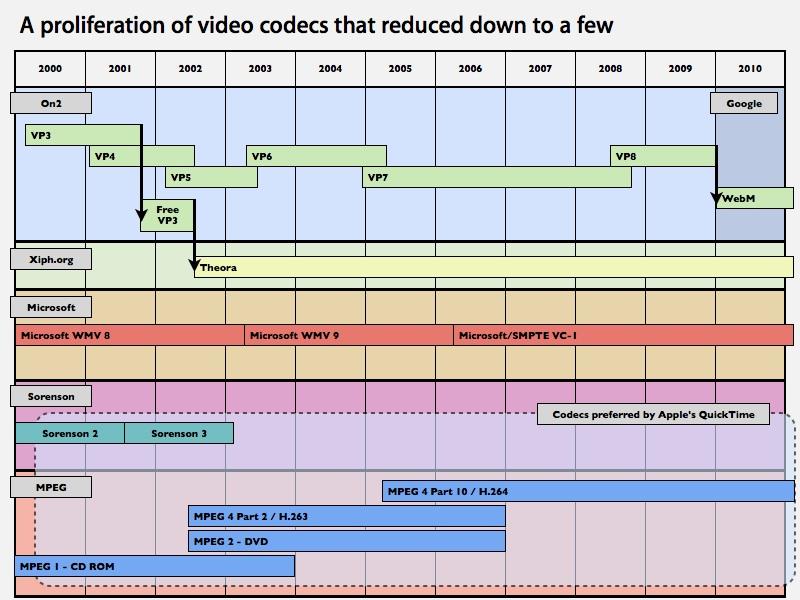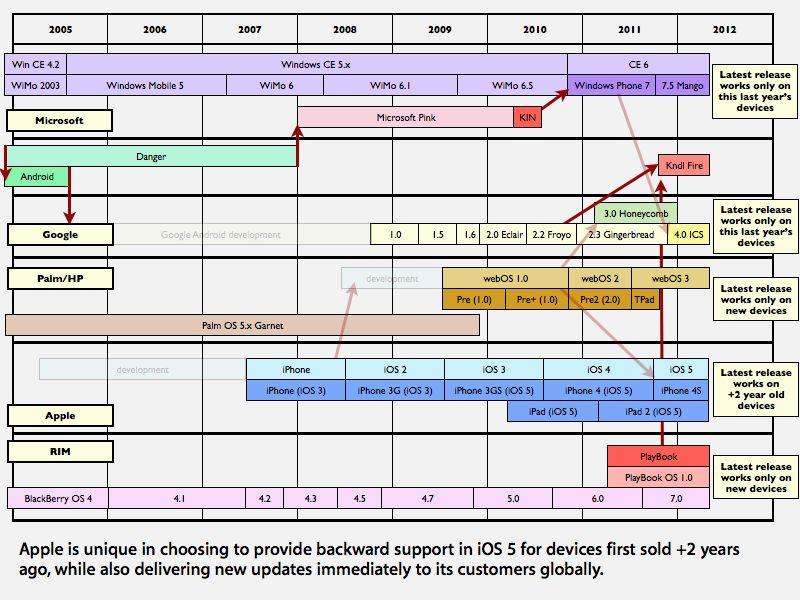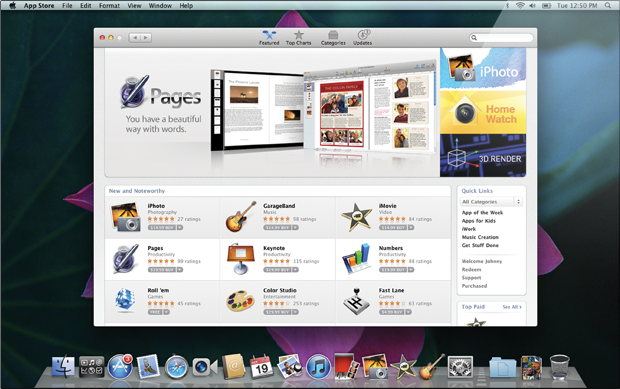The next ten years of Mac OS X
The next ten years of Mac OS X: core OS and web technologies
Steve Jobs launched the initial 10.0 version of Mac OS X in March 2001, describing it as a platform Apple would use over the next fifteen years, or roughly the same period of time the "classic Mac OS" had been used to power the Macintosh at the time. When he said that, Jobs also likely had in mind that NeXT, which built the operating system that Mac OS X was built on, was itself 15 years old in 2001 (having existed since his departure from Apple in 1986).
Ten years ago, Apple was leveraging the proven technology and enabling potential of NeXTSTEP's Unix core, software largely being pushed forward by Linux and the FreeBSD, NetBSD and OpenBSD open source projects, to deliver Mac OS X as an viable operating system that could compete against Microsoft's Windows NT-based offerings. Over the past decade, however, Apple has become the primary vendor of Unix workstations and has arguably taken over in leading mainstream Unix development.
Apple now owns and administrates CUPS, the open Common Unix Printing System used by Linux and Unix distributions, and has taken the lead in replacing the aging GNU C Compiler (originally released by Richard Stallman in 1987 as the core of a free development toolchain for Unix) with its own, next generation LLVM/Clang/LLDB development tools. Because Macs and iOS devices share the same Xcode development tools incorporating these technologies, Apple now has enormous leverage in deploying technologies that can and will gain broad adoption, something it struggled to do just a decade ago.
A parallel example of this is that Apple has taken over the role of leading development of the open source web browser with WebKit, a move that has pushed the commercial web from supporting proprietary plugins such as Adobe Flash and Microsoft Silverlight to backing the open HTML5 specification, with Apple openly (and freely) sharing its own Canvas 2D HTML5 drawing technology and other community co-developments and advancements related to CSS and JavaScript.
While leading and advancing open development of core OS technologies, tools and platforms, Apple has also achieved a driving position behind open standards. In media, this has shifted the world from incompatible competition between QuickTime's Sorenson codecs, Microsoft's Windows Media, Real Networks and Flash/On2 TrueMotion and replaced it (in just the last few years) with open competition based on MPEG AAC/H.264.
Apple has also bridged incompatible efforts by ATI and NVidia to drive open standards for graphics development and general purpose computing that can take full advantage of advanced graphics processors from any vendor, backing the existing OpenGL and OpenGL ES and developing OpenCL itself as an open specification for spinning off computationally complex tasks to any and all available processor cores. Apple has also supported the Khronos Group's COLLADA 3D format in its new Scene Kit, which appears to have the potential for meshing with sophisticated new mapping appellations Apple has hinted at for iOS (and which have spurred the company to acquire three maps-related companies over the past few years).
While the user interface of Mac OS X Lion (and its iOS sibling) continues to drift toward simplicity, its underpinnings are becoming increasingly sophisticated, with support for new code parallelism, managed by Grand Central Dispatch, to take advantage of multiple cores and new types of processor cores, as well as newer storage technologies (such as SSD) which require new ways of working with data to fully optimize their advantages. At the same time, Apple has finally gotten to the point where it can put down a series of outdated APIs (notably Carbon, the procedural development tools inherited from the classic Mac OS) and focus exclusively on modern 64-bit Cocoa, just as iOS devices have.
Mac OS X and iOS have shared technologies back and forth in each major release. In the near future, Mac OS X is likely to absorb recent iOS 5 feature including expanded Twitter integration; new support for configurable, app and system originating notifications (including getting iMessage from and sharing proprietary IM iChat features to iOS); iOS-exclusive App Store features including in-app purchases and Game Center support; system wide support for AirPlay video distribution (rather than just from iTunes); assistance features powered by Siri and expanded support for iCloud documents (including support in new iWork apps) and data management (such as the reappearance of Settings and Keychain sync between Macs, lost in the transition from MobileMe to iCloud).
On page 2 of 2: He with the gold makes the rules, Simplicity shift
Over the next decade, Apple will continue to lead the development of web standards and incrementally share and incorporate core OS technologies with the greater Unix community, very likely on a faster pace than it has previously, simply because it now has a very different position in the technology world that it had ten or even five years ago. Apple will continue to gain stature in pushing the direction of operating system and software development technology, in large part because it is now building the most hardware and earning the most profits.
The company is on course to pass HP in personal computer shipments next year, but it also now has a smartphone and personal music player business that leads Nokia, Samsung or Sony, forcing market research groups to divide Apple's sales into segments so they can be compared in unflattering ways against dissimilar sales of products (the entire mobile market), groups of manufacturers sharing a common element (such as the Android "platform") or mass shipments of products that are not profitable nor sustainable (HP's abandoned TouchPad or Amazon's loss leader Kindle Fire).
Beyond unit sales, Apple also earns far more in revenues and profits than any of the various hardware makers it competes with in device sales. Additionally, Apple is one of the few companies that develops its own software platforms, giving it a unique ability to chart its own future and differentiate its products. The failure of HP's Palm webOS, Nokia's Symbian and RIM's Blackberry are only making Apple more unique in that regard. Conversely, the overall failure of Windows Phone 7 and the fractionalization issues (and pure lack of profit) affecting Android licensees are highlighting the advantages of owning one's own platform (the very reason Nokia, HP and RIM distanced themselves from adopting Android last year).
The future of Mac OS X and its mobile iOS sibling will harness new directions in technology: principally, computers that no longer rely on just faster GHz clocks but can take full advantage of multiple cores and multiple types of cores. Apple's advantage in mobile devices is already evident in the fact that, for example, Android devices like the latest Galaxy Nexus require 1.2 GHz, dual core processors with multiple CPU cores and twice the RAM to match the smooth graphics interface performance of the nearly three year old iPhone 3GS. Windows devices similarly require hotter chips and more RAM just to approximate the functionality of the far less expensive hardware of the iPad, a reality that has forced Microsoft to begin porting portions of its platform to run on more efficient ARM chips.
Simplicity shift
Apple will also continue its efforts to simplify away complexities in the computing world such as the conventional file system, replacing it with cloud-coordinated, secured documents that update intelligently across devices without requiring manual intervention by users. The App Store, iCloud, Internet Recovery, and iTunes Match have already revolutionized how software and content is distributed and stored, increasing erasing the necessity of physical media, which will in turn allow computing devices to become increasingly mobile.
And while Apple revolutionized the computing user interface over the last decade with multitouch gestures, winning an ideological battle against devices driven by primarily by physical keyboards and buttons, Apple's Siri promises to lead a new charge in pushing voice as a natural user interface, something that's even more intuitive than mousing or tapping, and for many people, more accessible.
Although Apple began the last decade by branching out into general purpose devices with the then new iPod (something that subsequently quickly overtook the Mac in sales volumes), it closed the decade with the vast majority of its unit sales (including half of its iPods) being driven by iOS, the mobile edition of Mac OS X.
Going forward, Apple is expected to venture into new markets with its operating system and development tools, increasing its presence in the living room on HTDVs and likely pushing further into the casual gaming market the iPod touch reinvented.
This year also marks the first year of the second decade of iTunes and the iPod, the future of which will be outlined in part two.
 Daniel Eran Dilger
Daniel Eran Dilger














 Mike Wuerthele
Mike Wuerthele

 Malcolm Owen
Malcolm Owen
 Chip Loder
Chip Loder

 William Gallagher
William Gallagher
 Christine McKee
Christine McKee
 Michael Stroup
Michael Stroup







